|
|
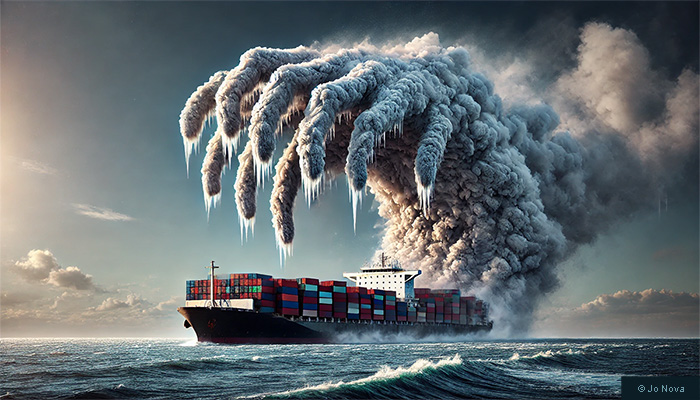
By Jo Nova
The evil shipping smoke was shielding us from global warming…
You’ll never guess but it’s worse than we thought, and we are more to blame than we thought, kiss my government grant and pray to Gaia.
Wouldn’t you know — shipping smoke was polluting the world, but the smoke also seeded clouds, which cooled the Earth, and undid some of the global warming we caused with CO2. Now that we are finally fixing up the dirty ships, oh no, we’ve accidentally unleashed the global warming which the ship smoke was hiding. So there is about to be another wave of global bad news. And for some reason we didn’t see it coming, even though we’ve known for decades that sulfate aerosols caused cooling (and we had those expert climate models all along, didn’t we?)
Remember all those other times they said disaster would strike, and it didn’t, well, they were right. It would have happened, we just couldn’t see it because of the shipping pollution.
See how perfect this is for The Climate Industrial Complex?
By Shannon Osaka, Washington Post
Tiny particles from the combustion of coal, oil and gas can reflect sunlight and spur the formation of clouds, shading the planet from the sun’s rays. Since the 1980s, those particles have offset between 40 and 80 percent of the warming caused by greenhouse gases.
“We’re starting from an area of deep, deep uncertainty,” said Zeke Hausfather, a climate scientist and research lead for the payments company Stripe. “It could be a full degree of cooling being masked.”
These moves have saved lives — according to estimates, around 200,000 premature deaths have already been avoided in China, and the new shipping regulations could save around 50,000 lives per year. But they have also boosted global temperatures. Scientists estimate that the changes in aerosols from the new shipping rule alone could contribute between 0.05 and 0.2 degrees Celsius of warming over the next few decades.
Some researchers have suggested that the changes to ocean shipping regulations may have been a big contributor to last year’s record heat…
All of which begs the question, if shipping-smoke solves global warming, shouldn’t we just go with it then?
I mean, let the ships rip, and skip the whole hair-shirt sacrifice — we could fly in planes, eat meat, and keep the air con on? But ‘no’ say the puritans, the new shipping regulations might save 50,000 people a year. (And heck, it’s not like we face the sixth mass extinction, boiling oceans, or something truly awful is it? ) So onward we go, renewables to the rescue, living the life of the perfect climate apostles.
The fact that the Ecoworriers won’t even consider this to save the world tells us exactly how afraid they are (not) of the man-made climate catastrophe.
And the other problem is “the numbers” — despite climate experts being 99% certain of what controls our climate, scientists estimate the changes in aerosols could have anything from 0.05°C to “a full degree” (so sayth Zeke Hausfather). So aerosols might explain a lot, or nothing at all, but it’s another excuse to parade a climate scientist on the news, and they can pick whatever flavour of “aerosol” cooling fits the theme of the day. Would you like to hide past model failures or scare the horses? Adjust to fit.
Watch the evil shipping smoke fighting off the Global Warming Monster
We are reminded yet again of the primitive belief that humans are really Gods that control the climate…

Some version of the shipping story keeps doing the rounds every few months for at least the last year, because it has a strong Climate Bingo score:
- It’s worse than we thought. The new bad effect is almost upon us (yet again!)
- It’s the perfect excuse to cover the warming that didn’t happen, wasn’t predicted, may not come, or might suddenly appear.
- It’s advertising for “Geoengineering Projects” where people throw salt, dust, or particulates in the sky and try to cool the Earth. (See, they say, Geoengineering works, give us your money!)
- It fits the religion — mankind controls the climate (not God or the Sun). This feeds a whole new wing of bureaucracy, and briefly distracts people from asking whether recent warming has anything to do with solar activity or space weather.
- Ultimately it bestows more power on the high priesthood of lab-coats and climate models — as long as the weather is controlled by man-made things of some sort, the IPCC anointed masters sit at the centre of this Global Warming Control Tower and issue the orders and collect the funds. They shall have their two-week UN junkets, their Nobel Pizzas, and their moment of fame in the nightly news.
But lift the hood, and this engine is a mass of contradictions. They didn’t see this “shipping” warming coming, and can’t agree on how much warming it does, but they want us to believe their models are accurate. And they don’t think the climate emergency is important enough to let ships keep shipping as they were, just to buy us some time. There are no hard trade-offs in these life and death decisions, only 50 shades of advertising for the renewables industry and the UN.
9.7 out of 10 based on 90 ratings
9 out of 10 based on 17 ratings
 MKinsey Survey By Jo Nova
EV Mandated Revolution hits a hurdle
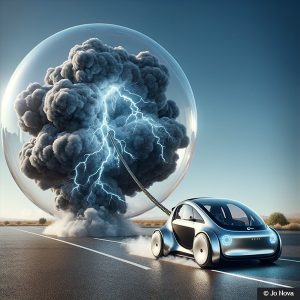
The first buyers of EV’s were their most passionate fans, and presumably the people-most-likely to love them, and in the best position to use them. Yet, when surveyed, 49% of Australians who owned an EV and 46% in the US said they want to go back to an internal combustion engine for their next car.
And the US and Australia are two nations where nearly everyone has a home-garage or driveway which makes EV ownership a bit easier (as long as the house doesn’t catch fire). Yet even with this cheaper and easier form of charging half the EV owners don’t want another one.
McKinsey & Co surveyed 30,000 people in 15 countries and were said to be surprised at the result.
Brad Matthews, The Washington Times
Nearly half of American owners of electric cars want to switch back to traditional cars powered by internal combustion engines, according to a consumer survey released by McKinsey and Co. earlier this month.
They had their reasons (boy did they have their reasons):
Among the owners surveyed who are planning to switch back, 35% cited the lack of charging infrastructure, 34% said the costs were too high, 32% said planning long driving trips was too difficult, 24% said they could not currently charge at home, 21% said worrying about charging was too stressful and 13% said they did not enjoy how the cars felt while driving.
Only 9% of drivers across all countries surveyed said that current charging infrastructure was sufficient to meet their needs. While some electric car drivers want to switch back, 38% of internal combustion car drivers surveyed said they are considering buying a battery-powered or plug-in hybrid electric car as their next vehicle.
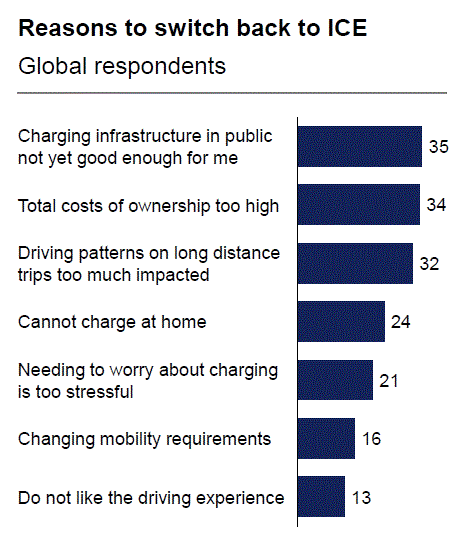
“I didn’t expect that. I thought, ’Once an EV buyer, always an EV buyer,’” Philipp Kampshoff, the leader of the McKinsey Center for Future Mobility, told Automotive News.
Since the McKinsey Centre for Future Mobility has a mission to help people “transform” the way they move, we would assume this survey was designed to show the more promising side of EV ownership.
The average EV owner planning to trade in for another EV around the world was 29%, so presumably there are some countries where EV’s are slightly less awful. Though that is not apparently in the British Isles. Actual trade-in statistics in the UK suggest the reality might be worse.
By Joe Wright, The Telegraph
“Car dealership chain Motorpoint Group said the majority of electric vehicle (EV) owners who sold their car in the last year didn’t buy another one – opting instead for a petrol, diesel or hybrid model.”
Statistics from Motorpoint show that only 30pc of EV owners part-exchanging their car in the past year chose to buy another electric car, with 36pc opting for petrol, 11pc diesel and 23pc hybrid.
Martin Bamford, a Tesla owner for four years, is one of the many electric car owners to switch back to combustion power in recent months. Despite driving a mostly trouble-free 34,000 miles, he suffered “instances of extreme range anxiety” and is ditching the zero-emission motor in favour of a 12-year-old Mini Cooper.
How much longer can the saviours of the world keep trying to force this dead-horse “transition” upon us?
The car manufacturers surely realize they are being forced into a financial dead end.
9.8 out of 10 based on 112 ratings
8.4 out of 10 based on 16 ratings
9.4 out of 10 based on 22 ratings

By Jo Nova
It wasn’t supposed to be this cold and windless in Australia
For some reason that no climate model can explain, Australia has run out of wind power three months in a row, which means we had to use more gas than expected. It’s also been colder than climate models predicted, despite global emissions being higher than ever in history. For some other reason that no rational adult can explain, the State of Victoria banned gas drilling for most of the last decade (to reduce the beachy-weather days in eighty years) and thus, as night follows day, the state is running out of gas. Ergo, predictably, it is also facing blackouts, cost blowouts and manufacturers dependent on gas are warning they may have to close down, or move to the US, where gas is still cheap.
If only the climate models could predict temperatures and wind even a month in advance?
The AEMO (our electricity grid manager) says Victoria will run out of gas before winter runs out of bite. Apparently Victorians are pulling twice as much gas out of their main storage as they can afford to at the moment. Not only does Victoria need the gas for electricity, but 80% of Victorian homes have gas for cooking or heating. And then there is manufacturing, not just in Victoria but most of Australia as gas prices rise all over the East Coast.
Who needs explosives and fertilizer, anyway?
Orica — one of the largest gas users in the country warned it may have to cut production and jobs in Newcastle due to the gas shortage. Since they supply explosives to the mining industry, and Australia is a big quarry, the repercussions would spread quickly.
By Perry Williams, and Rhiannon Down, The Australian
The nation is facing a deepening energy crisis on two fronts, with gas shortages so acute that Victoria’s main storage plant is set to run out by the end of winter and one of Australia’s biggest manufacturers warning it will slash jobs and close factories if supplies remain short.
German Morales, Orica’s president for Australia Pacific and sustainability, told The Australian that “there is not enough gas and there is not affordable gas”.
“Clearly if we fail to secure long-term gas at a reasonable market price, we may be put in a position of rethinking what is the manufacturing strategy for ammonia in Australia,” he said. “The Australian gas price is significantly more expensive than that you can buy in other jurisdictions, such as the US. That’s making it very difficult to justify manufacturing in Australia.”
And we thought wind generation was bad in April and May but June may be worse.
The awfulness of the fickle wind is upon us and reaching into our wallets. This was the total contribution of 11.5GW of wind generation to our national grid this month. Paul McArdle from WattClarity said the capacity factor for wind is as low as 21%.
Not-so-coincidentally on June 4th and June 13th when wind generation was exceptionally low, average prices in the whole system doubled (See below).
And this is a major problem with an electricity market that isn’t designed to find the cheapest solution for consumers. Cheerleaders like the CSIRO will still be saying “wind is cheap” when it’s obvious the lack of wind in a wind-dependent-system is very expensive. But these price spikes that were caused by wind turbines will be slapped on coal, gas or hydro, whatever rescued the grid, not on the wind industry. The more wind fails, the “higher” the prices are for its competitors. Neat eh? If only the “experts” at the CSIRO understood how unreliable wind drives up the cost of everything else on the grid.
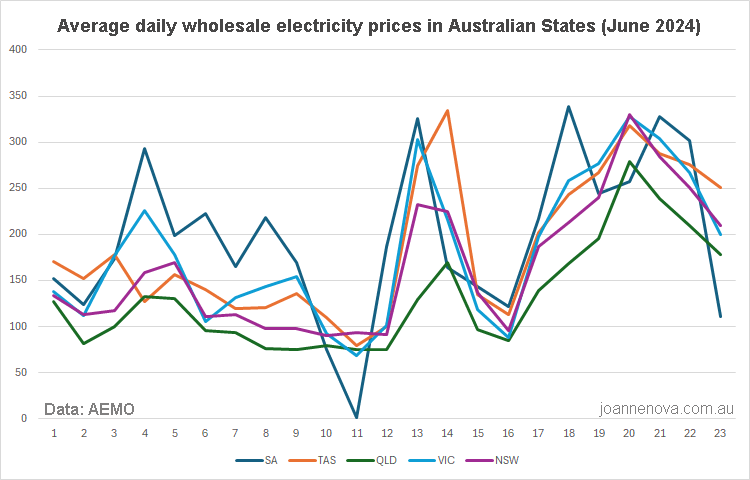 Bad days for wind were June 4th and June 13th, then most other days too. Those prices are awful and often obscenely high across all five states… On June 13th wind generation fell to just 88MW at lunchtime, and was low all day. The spike this produced is obvious.
Some of the lows like June 20th caused mayhem because they were hitting at dinner time when solar power has gone to bed. Back before the subsidized renewables gold rush, prices would average $30/MWh across the whole grid — not just all day, but all month. This month so far, average prices respectively are SA $197, Tas, $287, Qld $132, Vic $182, NSW $165.
It takes some skill to run out of gas when we are also one of the Big Three LNG exporters in the world, but the Australian government has achieved this. Incompetence knows no bounds:
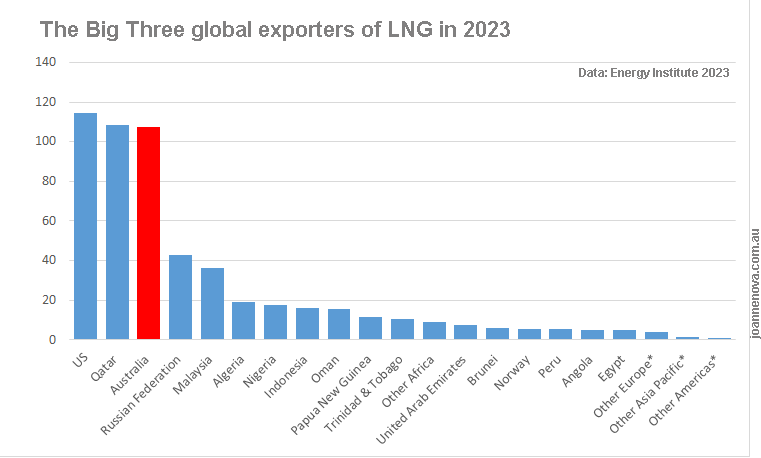
But hey, winter might be warm from now, who knows?
Not to belabor the point, but if we had decent climate models, we would know.
Gas price cap train wreck on the way
by Saul Kavonic, The Australian
The gas industry is scrambling to try to squeeze out any incremental supply, going as far as blending extra LPGs into the gas stream to eke out an extra per cent or two of production. Every lever to lift supply has now been pulled.
Australia’s energy market is one hiccup away from a major crisis, again. The gas market train wreck – long visible on the horizon – is now in front of us. Set in motion by Labor’s hostile gas policies since 2022, there are no easy levers left to pull to keep the lights on, while also keeping us warm in winter, and manufacturing jobs going. And it is only going to get worse in the years ahead.
If we run out of gas, we’ll just have to burn diesel, or sit in the dark, banging our heads on a cold wall.
Image by ThankYouFantasyPictures from Pixabay
10 out of 10 based on 124 ratings
9.1 out of 10 based on 36 ratings
9.1 out of 10 based on 21 ratings
By Jo Nova
We may be living through some of the best weather in the last 100,000 years
Kenneth Richard at NoTricksZone reports on a new paper showing the incredible extreme climate shifts of Greenland. During the depths of the last ice age Greenland temperatures would swing abruptly by 10 to 15 degrees Celsius (or 30F) in the space of 30 years. And we’re panicking at the moment about warming at 0.13°C per decade.
These Dansgaard–Oeschger (D–O) events occurred 24 times from 120,000 years ago until 11,000 years ago. There were no humans living there at the time, as far as we know. The best estimate is that people first arrived in Greenland 4,500 years ago. As far as we know, it’s only Greenland that was gyrating wildly in temperature but the bare truth about climate scientists is the expert models can’t predict or explain any of this. So the seismic shifts came and went and went and came, and it had nothing to do with whether you turned the airconditioner on.
If any poor sodding homo sapiens did manage to wash up on Greenland during the peaks 30 or 40,000 years ago, their little villages would have been wiped out in a blink.

Click to enlarge.(Kypke and Ditlevsen)
After 100,000 years of savage cold and shocking volatility, the world warmed nicely into the wonderful Holocene period. Humans moved to Greenland, and things were green.
Unfortunately the warmth started to get rarer and rarer in the last few thousand years:
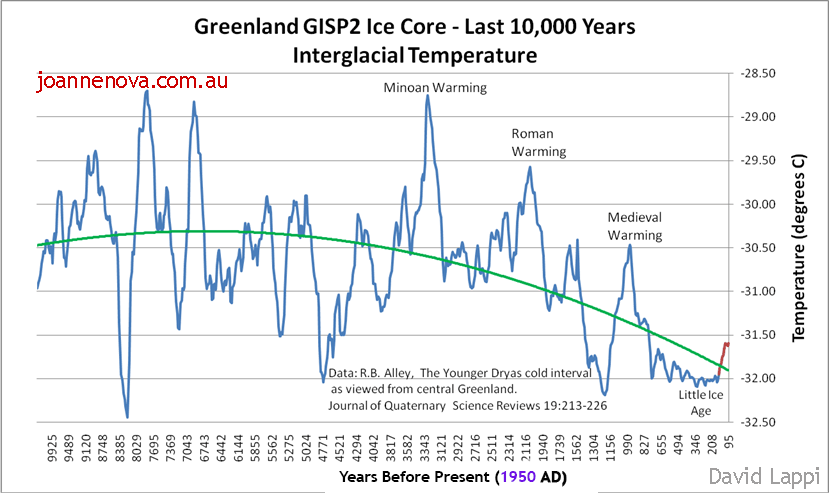 7,000 years of cooling in Greenland. UPDATE: This graph shows the ice-core data up until 1855. The last 150 years (1705 to 1855) are highlighted in red to show the warming as the Earth began coming out of the LIA. But in the last 150 years we’ve warmed out of the Little Ice Age and despite humans building the first coal fired plant in 1880 and putting out 99% of all the carbon dioxide we’ve ever put out, the temperature there has barely moved at all. About 6,500 million people have been born on Earth since 1880 and it’s made hardly any difference.
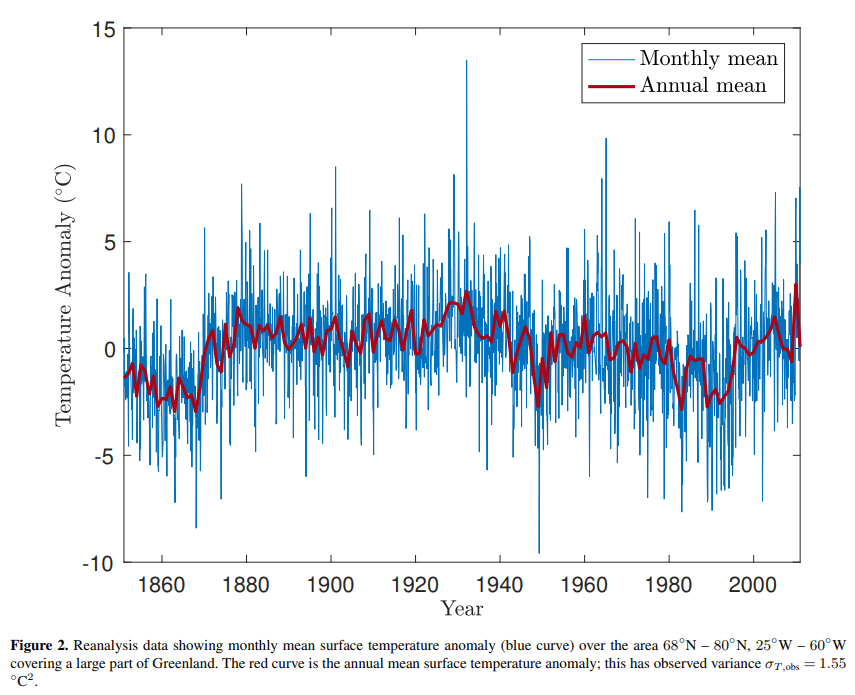 Greenland surface temperatures ( Mikkelsen et al., 2018) So despite the climate of Greenland being in the news every year, somehow the award winning journalists and the Nobel prize winning scientists forget to mention that the temperatures on Greenland have been largely stable recently despite humans emitting 1.7 trillion tons of CO2.They also fail to explain that Mother Nature is a thousand times more brutal than anything our cars, trains and planes have done.
But who cares about cause and effect? There’s always a way to make it look bad: Big Meaningless Numbers!
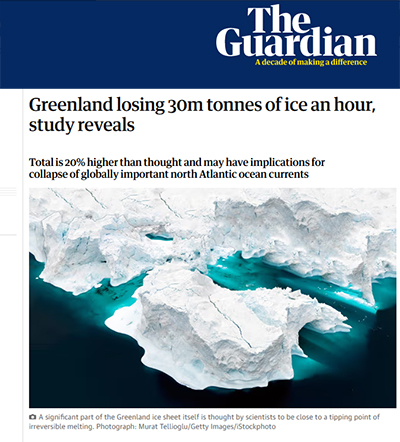
PS: Today in Greenland, a fisherman actually netted a fish with three eyes. Someone should tell the Australian Labor Party. They need it to explain their national energy policy.
REFERENCES
Kolja Kypke, Peter Ditlevsen (2024) On the representation of multiplicative noise in modeling Dansgaard–Oeschger events, Physica D: Nonlinear Phenomena, Volume 466, October 2024, 134215, https://doi.org/10.1016/j.physd.2024.134215
Mikkelsen, T. B., Grinsted, A., and Ditlevsen, P. (2018)Influence of temperature fluctuations on equilibrium ice sheet volume, The Cryosphere, 12, 39-47, https://doi.org/10.5194/tc-12-39-2018, 2018. Full paper plus Supplement
Greenland photo by Johannes Plenio on Unsplash
9.9 out of 10 based on 86 ratings
8.9 out of 10 based on 19 ratings
By Jo Nova
Global fossil fuel use hits a new record level in 2023
We spent $1.77 Trillion dollars on the clean energy transition last year, yet our fossil fuel use is still rising and our emissions are still increasing.
The Energy Institute released their annual “Statistical Review of World Energy”. Total energy used in the world went up by 2% showing no sign of slowing down. For the first time, more coal was used in India than Europe and North America combined, a trend that is unlikely to stop soon. Despite there being more EVs on Earth than ever before, oil consumption was up 2% to above 100 million barrels for the first time. China overtook the US as the country with the largest oil refining capacity in the world last year at 18.5 million bpd. But the US overtook Qatar as the largest exporter of LNG. And global man-made emissions of carbon dioxide exceeded 40 gigatons for the first time.
Imagine what a different place the world would be if we spent that money on something useful? Just a tenth of that might provide clean water and sanitation for the poorest of the poor and stop children dying of dysentery. Instead, wealthy nations build spinning totem poles — hoping they’ll give us the perfect amount of rain 80 years from now.
Despite what they say, we are still a fossil fueled world. Coal, oil and gas made up 81.5% of the world’s total consumption of energy, down from 82% a year before.
Not much of a “transition” — renewable energy makes up only 8% of our total global energy
And despite having every data-point since 1951, the Energy Institute were careful not to draw a graph like this below showing just how irrelevant unreliable renewables are (so I did one).
And despite ten years of rampant growth in renewable energy, and 28 UN global junkets, the trend in man-made global emissions is not slowing down.
The Energy Institute also apparently didn’t want people to see a graph like this one either — drawn by OWID from the Energy Institutes own 2022 data. Nothing else quite captures how fake or pointless the whole forced “Transition” is.
Headlines will presumably hail the record amount of renewable energy produced like it means something.
With great timing three professors of sorts at University College London wrote this unwitting satire at The Conversion* only two days ago:
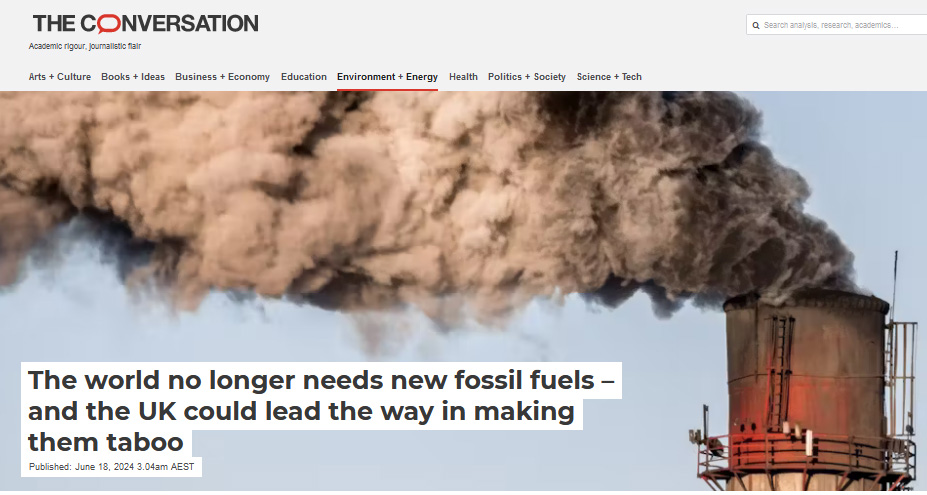
Proving the government can strangle any hard science if it throws enough money at it. Should we make 80% of the world’s energy “taboo” or should we just discuss the pros and cons like grown ups?
REFERENCE:
The “Statistical Review of World Energy — 2024”.
*Since The Conversation banned the dangerous “climate deniers” it’s hardly a conversation. We wish them luck in overcoming their fear of alternate scientific opinions.
10 out of 10 based on 97 ratings
The shortest or longest day
The point where the tilt peaks is at 6:50am EST Australia which is 4:50pm Thursday in New York.
9.6 out of 10 based on 32 ratings
By Jo Nova
It’s just another day on the job to save the world from man-made pollution
In a quest to make the weather a bit nicer in 100 years these trees needed to be cut down now so we can connect up a big hydropower “battery” for holy solar and wind power. The towers will be 75m high and the path through the forest, 140m wide.
When we ran off coal and gas power, we didn’t need pumped hydro. Fossil fuels protect the forests and hills of Australia.
These photos were posted by Geoff Wise on the “High Country of Australia” show us what our clean green future will look like:
“Here is where the power lines from the Snowy Hydro 2, at Lobs Hole, will cross the Tumut River ravine to go to the recently cleared site of the switching station in the Maragle State Forest, before heading north to feed into the National Power grid. The power lines will come from near the distant horizon. Look at the photos for more information. You can see this for yourself, as I was standing on Elliot Way when I took the photos, down hill, to the east is Kosciusko National Park and uphill, to the west is Maragle State Forest.”
Other parts of this project (not pictured here) will even cut through national park. Originally the 330kV interconnector towers were going to be put underground in the Kosciusko National Park, but after costs ballooned it was decided that the Snowy Hydro 2.0 pumped storage was “critical state significant infrastructure to NSW for economic, environmental and social reasons” and the National Park was not so significant. Who knew, socially, people in NSW benefit from pumped hydro?
Apparently renewable shareholders have friends in high places. Trees and koalas, not so much.
h/t Roger
Remember small business foresters and farmers are bad people, but industrial hydroelectricity helps the environment. See how caring they are with their clearing…
Geoff describes how extensive these lines are: “One of the power lines from there travels through Maragle State Forest, then Bago State Forest. A second travels through from Cabramurra and next to the new switching station being built. Snowy Hydro 2 may add, 1 to 2, more lines, as two lines are going to the switching station.“
The standard joke on facebook with these photos is “look at the damage those brumbies have done!”:
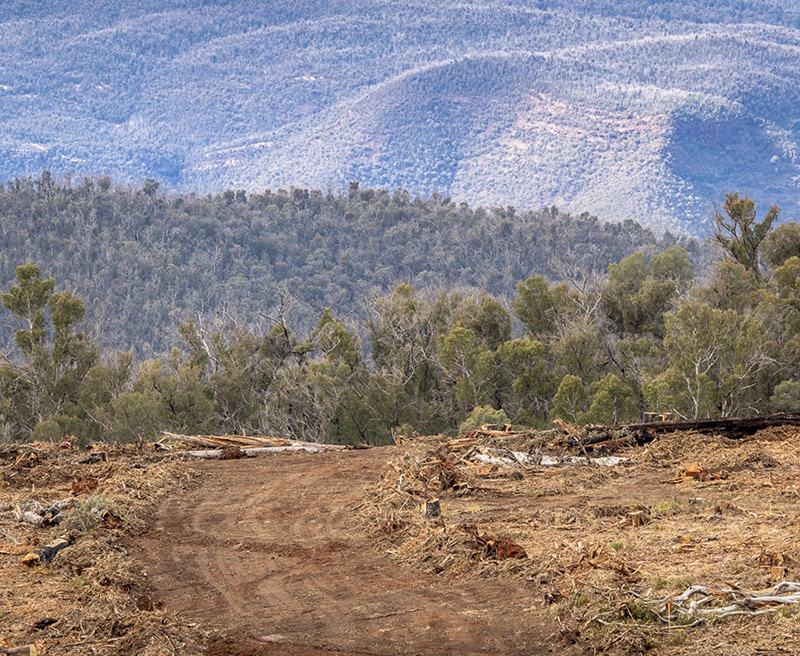 Clearing in the Snowy Mountains for high voltage lines (from Elliot Way) between Maragle and Lobs Hole. Because over the hill, feral brumbies are being shot from helicopters to “reduce their impact” on the Alpine wilderness.
Though some wonder if it’s more the high country colonial history that the bureaucrats are really trying to kill.
Geoff also notes the irony that electric vehicles will be everywhere in the renewable future, but they won’t be allowed in the Snowy hydro power station. He wonders, after all the combustion engines are gone, whether they’ll need those horses to pull the carts:
I received an email from a well informed commentator who noted that the Lobs Hole approval notice is allowed to kill and displace all sorts of things:
The Critical State Infrastructure Approval for the Lobs Hole and the Switching Station on KNP allows that no more than:
(i) 9.35 ha of Caladenia montana species habitat
(ii) 89.06 ha of Gang-gang Cockatoo (breeding) species habitat
(iii) 10.86 ha of Masked Owl (breeding) species habitat
(iv) 117.29 ha of Eastern Pygmy-possum species habitat
(v) 59.03 ha of Yellow-bellied Glider species habitat; and
(vi) 1.67 ha of Booroolong Frog species habitat
can be cleared for the development; and the developers have to minimise:
(i) the impacts of the development on hollow-bearing trees;
(ii) the impacts of the development on threatened species; and
(iii) the clearing of native vegetation and key habitat.
Apparently, the sanctioned clearing is offset by contributing or buying offset credits.
The question is, why can’t farmers within the Great Barrier Reef catchment area have the same option when managing their land? At the moment, bureaucrats scan satellite images and if any bare ground the size of a kitchen table is found on their land, they turn up and carry out an audit essentially accusing the farmer of environmental degradation of the Great Barrier Reef.
— R
Some endangered industries are more protected than others.
10 out of 10 based on 114 ratings
8.9 out of 10 based on 16 ratings
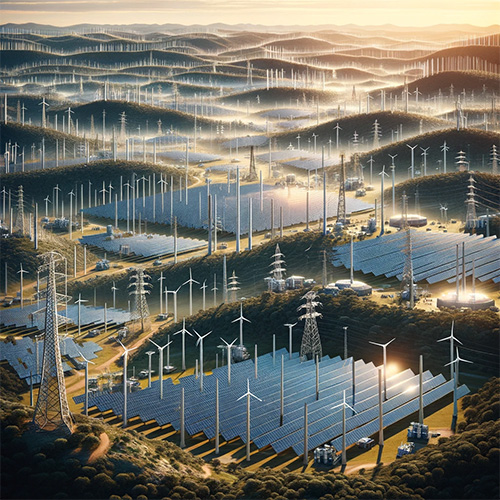
By Jo Nova
The Renewable Crash Test Dummy hits a fork in the road
Finally the Australian opposition is bravely popping the sacred cow of the Energy Wars. The Dummy nation was aiming for the holy grail “low emission” grid that no other nation had tried. The driest continent on Earth, with small hydro, and no extension cords to any nuclear power, were going to build the perfect grid based on the wind and sun alone. It was always doomed to fail, it was just a question of how much money would be burned at the pyre before the Crash Test Dummy crashed.
Because they didn’t do their homework, and the fan-media didn’t ask them to, the Labor Party set themselves up to fail. They left their left flank wide open, and the Opposition is finally launching the missiles that have been there all along in the mist. The ultimate low-emissions generator was always and obviously the unspeakable nuclear power. It’s a fifty year old technology. If anyone actually cared about carbon dioxide, they would have done this instead of the Kyoto scheme in 1997. But it was all a theater of grift and graft for unreliable, fairy energy, or for self-serving players who like trips to ski clubs in Davos, or jobs after politics with the UN or “energy companies”. (Not mentioning any names, Matt Kean).
Australia doesn’t need more “large-scale renewables” says the Opposition party, offering nuclear power instead of renewables technohell
Finally the dirty laundry of renewable power might be hung out to dry in an election. After ten years of rampant renewables growth in Australia, a dawning realization is sweeping the nation that wind and solar are not cheap, and will never be cheap. It’s hard to believe only two years ago Labor won on promises to bring electricity costs down by $275 dollars a household, only for prices to rise by $750 instead. At the same time, the awful reality of collecting low density energy is all too apparent in regional areas where developers are swarming to cover the land in renewables infrastructure. No one wants industrial plants in their backyard, but when we have to build 10,000 kilometers of high voltage towers, 40 million solar panels, and 2,500 bird killing turbines — its in everyone’s backyard.
Suddenly the real environmentalists are the ones who just want to build seven small nuclear plants on old industrial sites. Save the eagles, spare the whales, and don’t club the koalas, OK? The opposition are promising to build nuclear plants on the old coal sites, give cheap electricity to locals and to block major offshore wind projects and oppose large solar plants too. As they so aptly say, the low hanging fruit on this tree are already done.
This is the Deputy Opposition leader saying what was unthinkable only a year ago:
By Rosie Lewis, The Australian
Nationals leader David Littleproud has said a Coalition government will look at alternative energy sources so it doesn’t have to pursue large-scale renewables such as wind and solar, after suggesting he would axe an offshore wind industry if elected.
Amid a pre-election brawl over climate and energy policy, Mr Littleproud said the Coalition would send “strong investment signals” that Australia didn’t need large-scale industrial wind farms onshore or offshore or other big renewable projects.
Mr Littleproud also indicated to The Australian that he was opposed to large-scale solar farms, saying: “We’d like to look for whatever option we can so we don’t have to pursue large-scale renewables full stop.
“All the low-hanging fruit for large-scale renewables has been done, we’ve now got to go out beyond that.
He had to clarify that one big wind farm offshore would go ahead, but one that was just approved this week in the Illawarra, would not. The Coalition says the Commonwealth will own the nuclear plants. They’ll build them in the Latrobe Valley in Victoria, the Hunter Valley in NSW, Collie in WA, Port Augusta in South Australia, and the southwest Queensland electorate of Maranoa.
According to The Australian Peter Dutton said in April that the “first small modular reactors could be operational by the mid-2030s, following a meeting with British manufacturer Rolls-Royce, which told the Coalition it could deliver them at an estimated $3.5bn to $5bn each. Rolls-Royce is contracted by the Australian government to supply the nuclear reactors for the AUKUS submarines.”
Nuclear power is the sleeper policy — even half the Greens agree the government should be talking about it
Last year political number crunchers suddenly realized there is no mass anti nuclear protest movement here, just the ghost of one from forty years ago. Polls came out in May 2023 showing that with virtually no national discussion about it, right out of the starting blocks, fully 56% of Australian voters thought the government should seriously consider small modular reactors (SMRs), and only 12% disagreed. Which is all the more astonishing given that only 24% of Australians even knew about SMRs at the time.
Wait until Australians find out there are 440 nuclear power plants in the world, and that even Armenia has one. And Belarus.
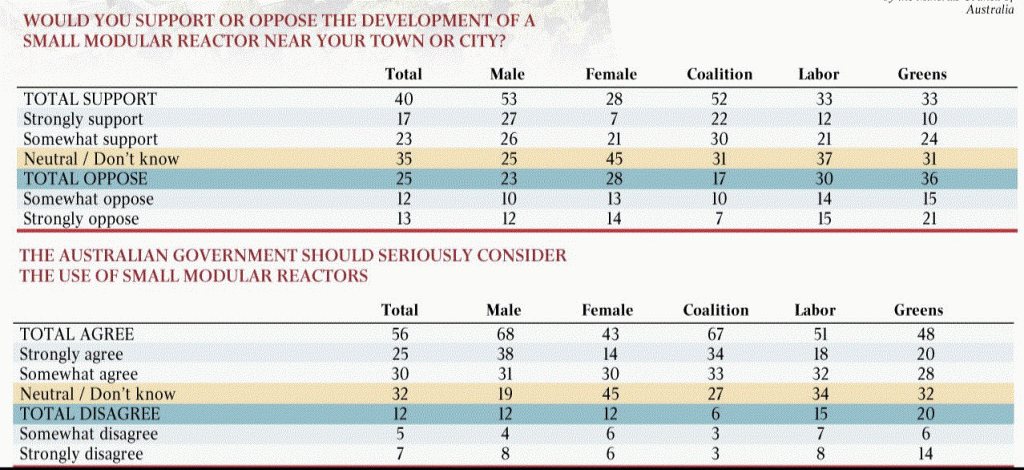 The Australian: commissioned by the Minerals Council of Australia | Insightfully polled 2,400 people, May 2023.
When will we get over the adulation of roof top solar?
Not everything about the Coalition plan is smart, Australia already has a glut of solar power at lunchtime, so promising to put more on roofs in capital cities isn’t going to help. It’s just more electricity we can’t store at a time of day when we don’t need it which non-solar households have to subsidize. The duck curve at noon vandalizes the market for reliable generators, which have to recover costs at breakfast and dinner time anyway. And one cloud can cover a million suburban houses simultaneously. There goes another gigawatt.
If a large solar plant doesn’t make sense in Alice Springs where there is no cheap coal fired power, it certainly doesn’t make sense in Sydney where there is. Most new solar panels in capital cities are a waste of glass, metal and labor that someone has to pay for. They are a pagan shield against the storms, supposedly protecting coral reefs from somewhere in Parramatta.
But we all had cheaper electricity when no one had solar panels.
Thou still shall not question the science
The bottom line, which neither party is saying, is that we need to get the science right before we start pretending to change the weather — not after we blow a trillion dollars making high voltage temples to fend off the evil spirits. Nuclear plants are good, but coal plants are cheaper, and CO2 is a gift from God. The world should pay Australia to burn more of our coal and feed the forests and fields.
Who audits the foreign committee in Geneva? Which scientists are paid to find holes in the IPCC religious sermons about boiling oceans? We’re betting the nation on sacred-cow science.
Once we win the energy war we need to win the science war. Your donations keep me going. Thanks to the readers who help make this work possible.
—————-
*The conservative Coalition is the pairing of the Liberal Party and the Nationals.
9.9 out of 10 based on 128 ratings
10 out of 10 based on 10 ratings
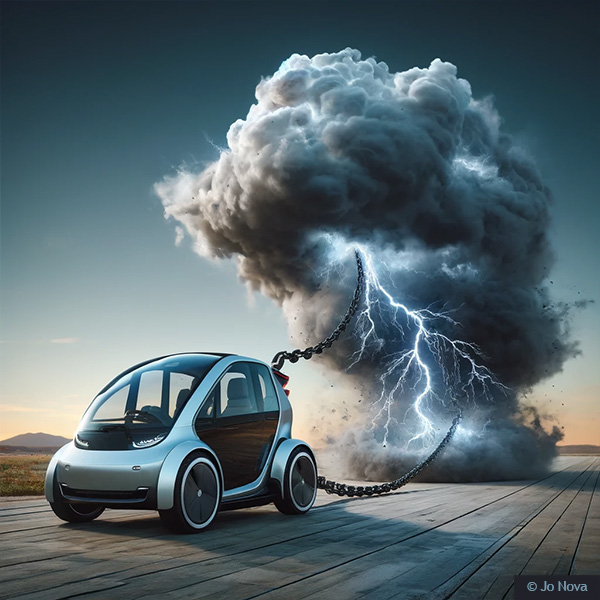
By Jo Nova
The cost problem is solved (for all the wrong reasons), but it’s still not enough
Around the world, governments are trying to force people to buy electric vehicles because they are nice people who are worried about polar bears. And since drivers out there all believe in climate change, according to all the pollsters, it shouldn’t be a big ask. (Who wouldn’t want to save the Earth?)
Supposedly, just 10 years from now, they told us, we wouldn’t be able to buy a new combustion engine car at all. Instead, not only are sales of new EV slowing rapidly, to the point where there is a glut, but as prices fall for used cars customers are not rushing out to pick up the cheaper second hand EVs either.
Look at how fast the turnaround in this market has been in the last year — a 25% price premium– gone:
Kaya Ginsky, CNBC
The difference between the price of a used Tesla Model 3 and BMW 3 Series shows how a “premium” associated with EVs in the initial boom has been erased, according to an analysis from iSeeCars.
The decline has been dramatic over the past year. In June 2023, average used EV prices were over 25% higher than used gas car prices, but by May, used EVs were on average 8% lower than the average price for a used gasoline-powered car in U.S. In dollar terms, the gap widened from $265 in February to $2,657 in May, according to an analysis of 2.2 million one to five year-old used cars conducted by iSeeCars. Over the past year, gasoline-powered used vehicle prices have declined between 3-7%, while electric vehicle prices have decreased 30-39%.
And all leading indicators are down. Fewer people have plans to buy an EV, and the pool of people who won’t even consider buying one is growing:
A Gallup poll of Americans in April found ownership of EVs increasing by 3% annually, but an equal percentage decline in consumers who indicated serious interest in buying an EV, down from 12% to 9%. Overall, 35% of Americans said they might consider buying an EV in the future, down from 43% last year.
In Germany, the formerly great industrial empire, EV sales are down 30% compared to this time last year, but sales of petrol engines are up 2% and diesel cars are up 3%.
Pierre Gosselin at NoTricksZone tells us the German Federal Motor Transport Authority (KBA) reports a 30.6% fall in registration of new electric cars compared to May a year ago.
CO2 emissions of new German cars also rose 3.3%…indicating the green transition has stalled and is reversing.
Hat-tip: Blackout News
The KBA also adds that 89,498 passenger cars were equipped with a gasoline engine – an increase of 2.1 percent compared to the same month last year.
44,893 new cars were diesel-powered, an increase of 3.2 percent compared to the same month last year.
History books will be written about the crazy political EV bubble.
9.9 out of 10 based on 120 ratings
9 out of 10 based on 11 ratings
7.8 out of 10 based on 29 ratings
8.5 out of 10 based on 27 ratings
|
JoNova A science presenter, writer, speaker & former TV host; author of The Skeptic's Handbook (over 200,000 copies distributed & available in 15 languages).

Jo appreciates your support to help her keep doing what she does. This blog is funded by donations. Thanks!


 Follow Jo's Tweets
Follow Jo's Tweets To report "lost" comments or defamatory and offensive remarks, email the moderators at: support.jonova AT proton.me
Statistics
The nerds have the numbers on precious metals investments on the ASX
|







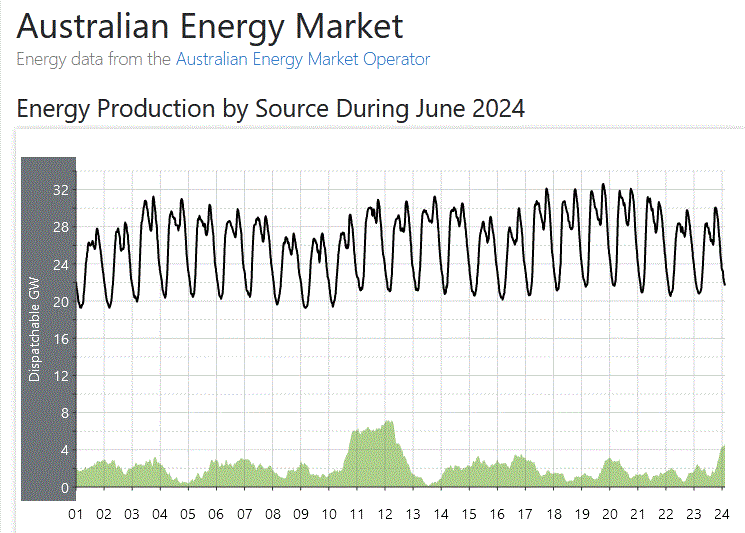







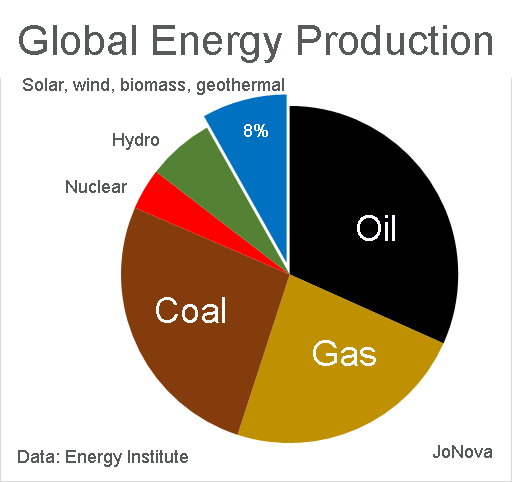
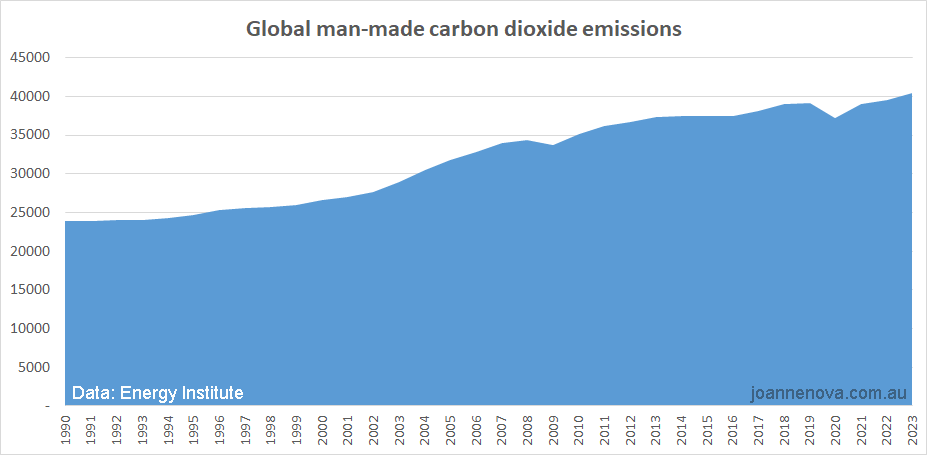
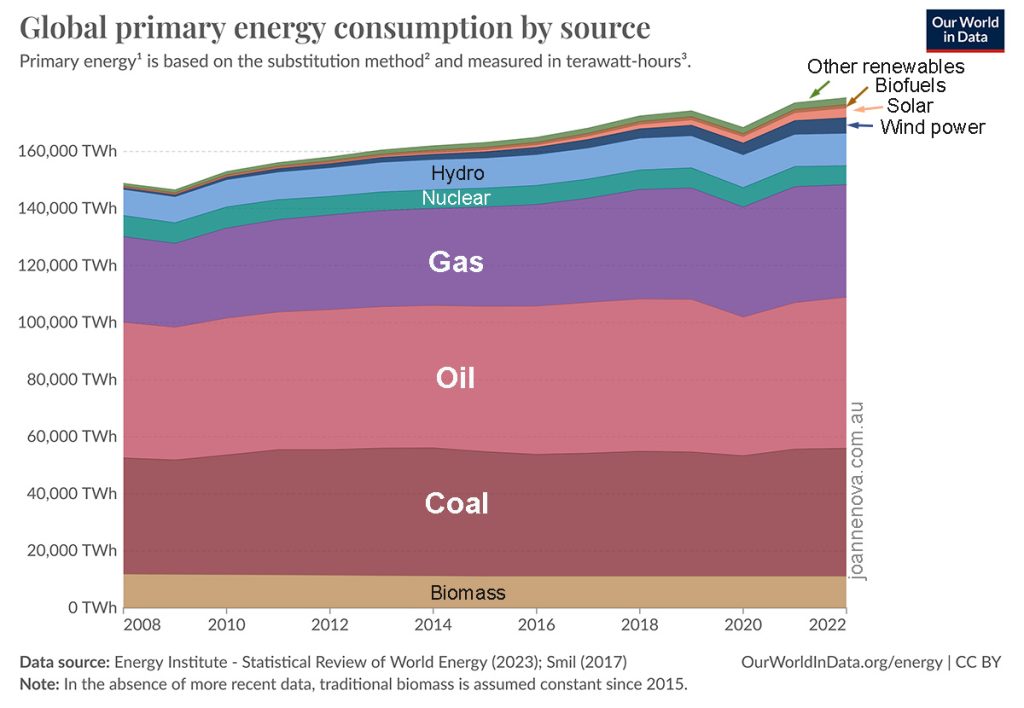

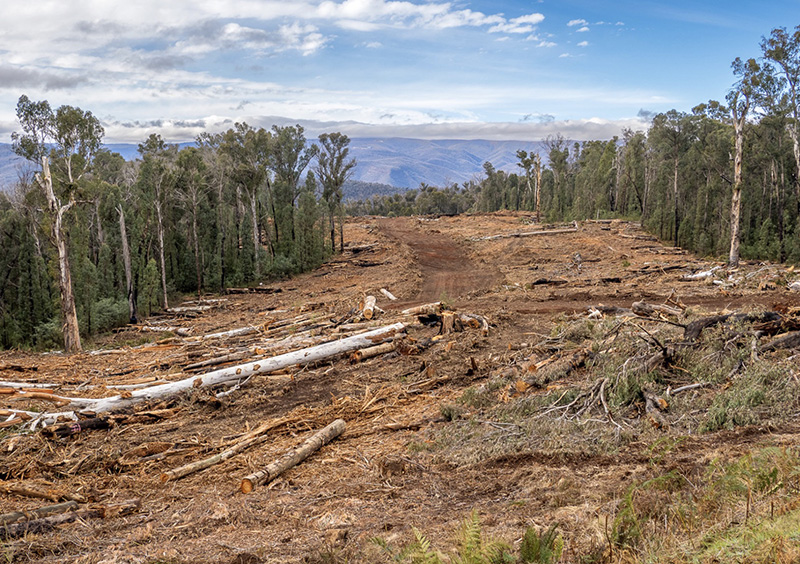
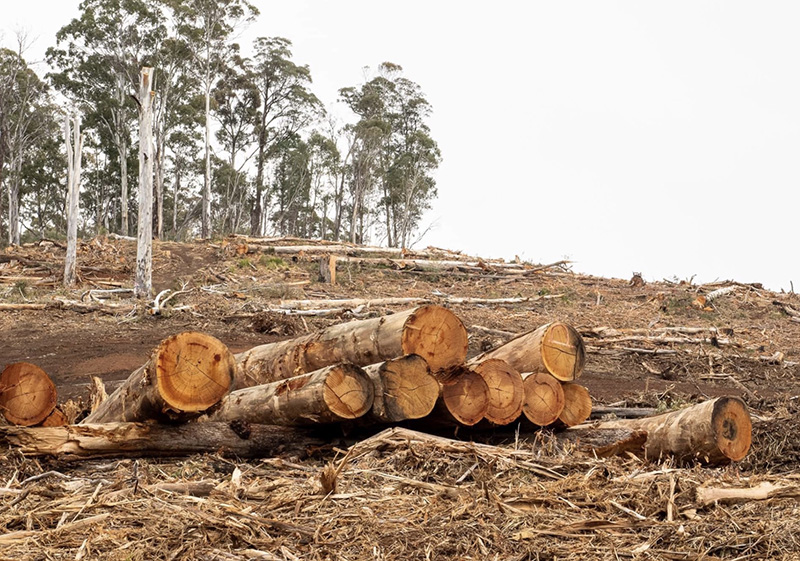

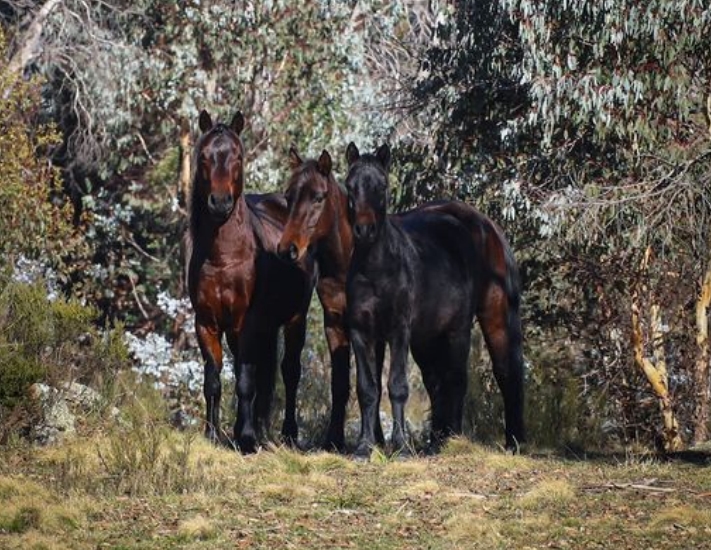
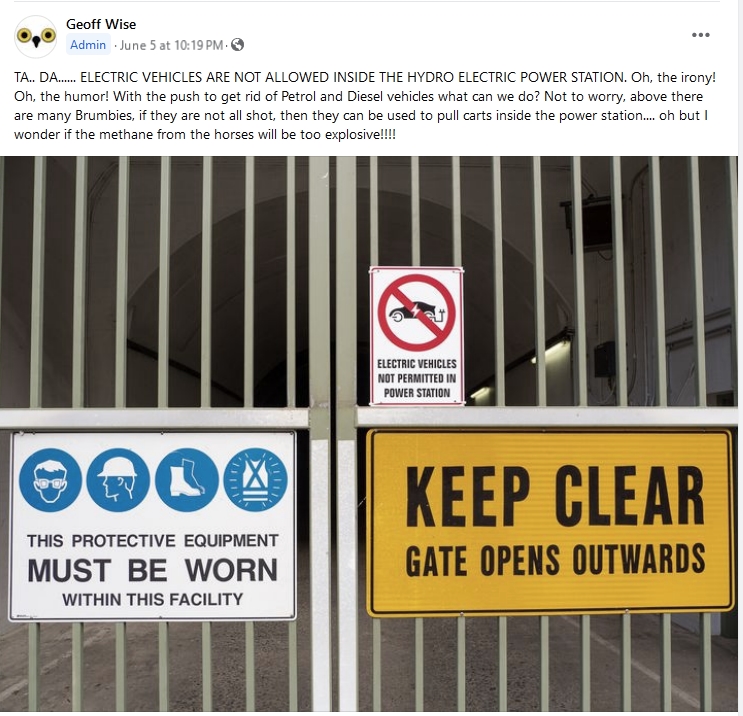














Recent Comments